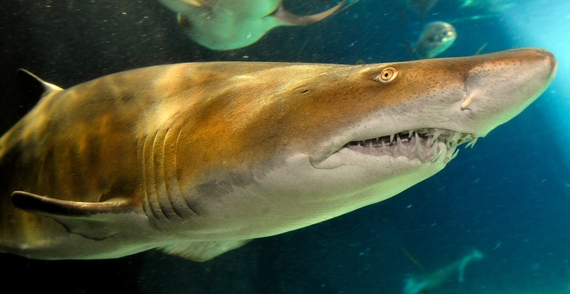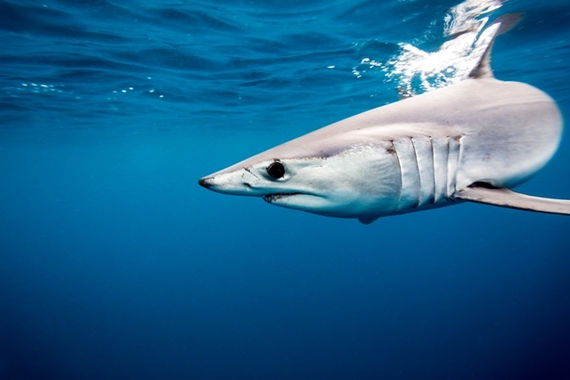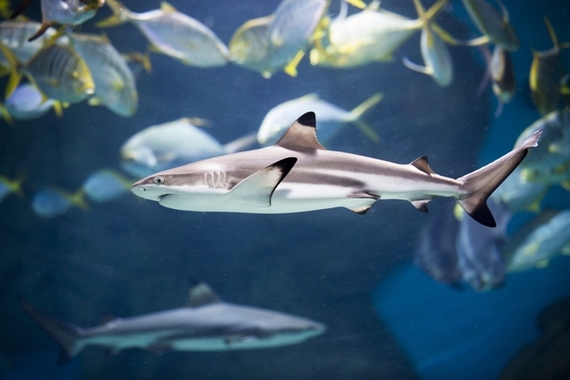
Last summer while enjoying a summer day at the beach in Montauk, my wife suddenly recoiled in fear as she spied a silvery fin cutting through the waves near shore. While the fin belonged to a dolphin, like many Americans she could not help but fear a shark attack -- a fear acquired four decades ago with the release of the film Jaws and exacerbated through years of scare-mongering videos.
The annual tradition of the Discovery Channel's "Shark Week" is a chance to dispel the many myths about sharks and spread awareness about their importance to our oceans and the danger they face. The truth is that sharks have more to fear from people than people do from sharks.

The Discovery Channel's "Shark Week" is a chance to dispel the many myths about sharks and spread awareness about their importance to our oceans and the dangers they face. Photo by Julie Maher © WCS.
A study released by the International Union for Conservation of Nature in January revealed that one-quarter of shark and ray species are threatened with extinction. Sharks are being overfished in all of the world's oceans, including the reprehensible practice of shark-finning, in which the fin of the shark is sliced off to make a certain kind of soup and the rest of the shark is discarded.
The answer is protecting sharks and the waters in which they live.
Most New Yorkers don't realize the underwater ecological splendor that exists just a few miles offshore. The New York Seascape provides habitat for migratory whales, sea turtles, seabirds, and other threatened marine species.

The New York Seascape is best known for its iconic oceanic sharks, including makos, threshers, and blue sharks, along with an occasional great white. Photo © Bryan Toro
This seascape is also a hotspot for nearly 40 species of sharks and rays, including the protected sand tiger shark and depleted thorny skates. Most relevant to viewers of "Shark Week," the New York Seascape is best known for its iconic oceanic sharks, including makos, threshers, and blue sharks, along with an occasional great white.
People are not as quick to recognize the ecological importance of undersea habitats because they are not easily seen. But that does not make them any less crucial to threatened wildlife, or make them any less incredible.
The crown jewel of the New York Seascape is the vast Hudson Canyon, an underwater chasm that is essentially a drowned riverbed that extends across the continental shelf. These submarine canyons shelter hundreds of marine species ranging from cold-water corals to sponges, anemones, and crabs to whales, sharks, tunas, and swordfish.

Although people are not as quick to recognize the ecological importance of hard-to-see underwater habitats, these areas are critical to protect. Photo by Stacy Jupiter © WCS.
The Hudson Canyon is the largest ocean canyon off the Atlantic Coast -- one of the largest in the world -- and actually rivals the Grand Canyon in size!
But like sharks, the Hudson Canyon and the New York Seascape face an uncertain future. The area is home to recreational fishermen and important commercial fisheries, but we need to remain vigilant in order to protect these delicate habitats and the species that live there.
Not too long ago we were dumping trash directly into the ocean. I recall as a young legislative staffer working with then-Assemblyman Eliot Engel our raising awareness of the "syringe tide" in 1988 that caused hundreds of beach closures and an estimated $1 billion in lost revenue to the local tourism industry.

The undersea Hudson Canyon shelters hundreds of marine species ranging from cold-water corals to sponges, anemones, and crabs to whales, sharks, tunas, and swordfish. Photo © Dreamstime.
Thankfully, these practices have stopped -- and fortunately, due to their depth and ruggedness, these undersea canyons have mostly avoided damage from humans so far. These fragile gardens of coldwater corals, sponges and anemones are critical for maintaining a thriving marine ecosystem.
If any place is worthy of protection, it is our very own underwater Grand Canyon, home to endangered sharks, whales and other awe-inspiring wildlife. A future without these sea creatures is scarier than anything you'll see on "Shark Week."
